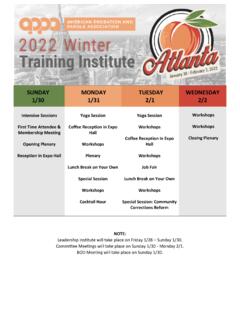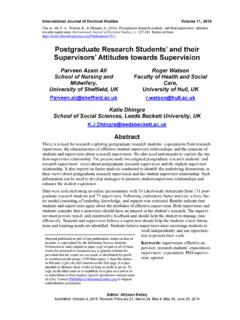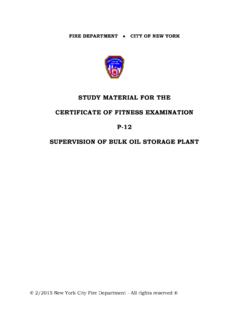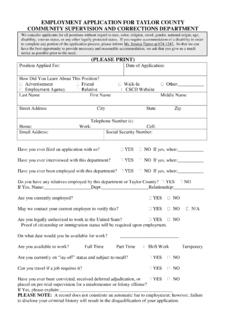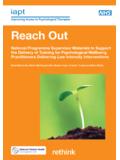Transcription of This report was prepared by the American Probation and …
1 This report was prepared by the American Probation and parole Association, in partnership with the National Center for State Courts and The Pew Charitable GRANTS AT WORK FORCOMMUNITY CORRECTIONSACKNOWLEDGEMENTS ..i Introduction ..1 Research and Rationale ..3 Swiftness and ..5 Incentives and Rewards ..7 Review of Empirical Evidence ..7 Lessons Learned ..10 Consider Legal and Constitutional Issues ..11 Apply Proper Ratio of Incentives to Sanctions ..14 Collaborate with Key Stakeholders ..17 Develop Structured Response Grids Using Key Principles ..18 Evaluate Program Fidelity and Outcomes ..19 Moving Forward.
2 22 References ..24 Appendix A: Summit Materials ..27 Appendix B: Response Grid Template ..28 Appendix C: Data Collection Elements ..29 Table of Contentsi Effective Responses to Offender Behavior: Lessons Learned for Probation and parole SupervisionACKNOWLEDGEMENTSThe completion of this publication was made possible through collaborations among several people and organizations. First and foremost, the representatives from 14 states who participated in a summit to share their experiences on this topic deserve gratitude. During the convening, these representatives worked together to address issues and develop action plans for their respective jurisdictions.
3 Some of their participation, however, also took place prior to the convening. In fact, 10 of the states worked with the project team to provide detailed profiles of their administrative response systems. Even since the summit, many of the states willingly shared the progress made in the implementation of practices and policies. The insights gained helped to identify the lessons learned as described in this , many experts and leaders in the field gave formal presentations at the summit on this topic, and they deserved to be formally acknowledged as well. Scott Taylor (Director, Multnomah County Department of Community Justice and Past President, American Probation and parole Association) and Bernard Warner (Secretary, Washington State Department of Corrections) provided insight on what has worked for their respective agencies in successfully implementing effective responses in Probation and parole supervision.
4 Drs. Brett Garland (Associate Professor of Criminology and Criminal Justice, Missouri State University) and Eric Wodahl (Associate Professor of Criminal Justice, University of Wyoming) gave an overview of the theoretical rationale and empirical evidence supporting the use of sanctions and incentives in community supervision. Lastly, Eileen Kinney (Evaluation Unit Manager, Colorado Division of Probation Services) and Becky Ney (Principal, Center for Effective Public Policy) discussed the importance of key performance measures in order to properly assess the effectiveness of the responses used in supervision.
5 Such expertise was invaluable to the development of this course, this report would not have been conceivable without the support from the Public Safety Performance Project of The Pew Charitable Trusts. Particular thanks are owed to Richard Jerome (Manager), Lindsey Carlson (Senior Associate), and Adam Gelb (Director). Each was involved throughout every aspect of the project and, specifically, contributed to the development of this report . Effective Responses to Offender Behavior: Lessons Learned for Probation and parole Supervision iiThe development of this report was led by the American Probation and parole Association s Nathan Lowe (Research Associate) and Mary Ann Mowatt (Research Associate), in partnership with the National Center for State Courts Matthew Kleiman, (Principal Court Research Consultant), Fred L.
6 Cheesman II, (Principal Court Research Consultant), Cynthia G. Lee (Court Research Associate), and Kathryn Holt (Court Research Analyst). Support and guidance was also sought from Carl Wicklund (Executive Director, American Probation and parole Association) and Judge Roger Warren (President Emeritus, National Center for State Courts). John R. Higgins (Graphic Designer, APPA) designed and formatted this report for publication. About the OrganizationsAmerican Probation and parole Association (APPA)APPA is an international association composed of individuals actively involved with Probation , parole and community-based corrections, in both adult and juvenile sectors.
7 Over the years, APPA has grown to become a strong, unified voice for thousands of Probation and parole practitioners, as well as educators, volunteers and concerned citizens with an interest in criminal and juvenile justice. APPA provides a wide range of services to its constituency, including training, technical assistance, and research on the most pressing issues facing the community corrections Center for State Courts (NCSC)NCSC, headquartered in Williamsburg, Virginia, is an independent, nonprofit court improvement organization. All of NCSC s services research, information services, education, consulting are designed to help courts plan, make decisions, and implement improvements that save time and money, while ensuring judicial administration that supports fair and impartial Safety Performance Project (PSPP), The Pew Charitable TrustsThe PSPP works with states to advance data-driven, fiscally sound policies and practices in the criminal and juvenile justice systems that protect public safety, hold offenders accountable, and control corrections Effective Responses to Offender Behavior.
8 Lessons Learned for Probation and parole SupervisionIntroductionUsing effective strategies to keep probationers and parolees crime- and drug-free and curb their revocation rates is among the most important issues facing our community corrections supervision system. From the early 1980s through 2005, there was a sharp decline in the percentage of adult probationers (from 79% to 59%) and parolees (from 60% to 45%) who successfully completed supervision (Bureau of Justice Statistics, 1984; Glaze & Bonczar, 2006). While there has been a period of stabilization in more recent years, Probation and parole agencies continue to seek alternatives to business as usual in community supervision.
9 This is mainly due to the fact that high revocation rates have had a detrimental impact on the criminal justice system, including extensive prison growth (see Pew Center on the States, 2008) and significant increases in costs for both corrections and the judiciary (see Kyckelhahn, 2012). The community corrections field has a responsibility to implement a more effective supervision process that enhances compliance and accountability among probationers and parolees, thereby improving public safety in a cost-effective these challenges, community corrections agencies are increasingly taking a more comprehensive approach in responding to certain violations and reinforcing compliance among probationers and parolees.
10 Decades of learning in the field and a growing research base has led to a consensus among many corrections professionals about what needs to be done to achieve better results and increase public safety. These strategies include, but are not limited to, assessing criminal risk and need factors, focusing resources on higher risk offenders, tailoring conditions of supervision to the risk and needs most likely to result in new criminal behavior, and balancing surveillance requirements and treatment needs (Solomon, 2007). We cannot assume that what is punishing for one is equally punishing for another; nor can we assume that what is rewarding for one is equally rewarding for another.





